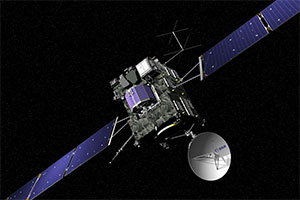The world’s most celebrated holiday—New Years’ Day! On average, each American makes about 1.8 New Year’s resolutions. If you take into account the rest of the world, the number of people making resolutions skyrockets to billions!
On this day, it’s familiar for many of us to reflect upon last year’s achievements and letdowns, and look forward to the promise of a new year and a new beginning.
As we look back on 2014, let’s recap the greatest scientific breakthroughs that have affected all aspects of modern life: from science to space exploration and the future of renewable technologies.
Earth Science
Mother Earth–the place we call home. A celestial dwelling coined as the “Goldilocks planet.” Just like the story of “Goldilocks and the Three Bears,” the little girl had to have everything just right. Goldilocks porridge couldn’t be too hot or cold, and equally, so the Earth has to be just right for living conditions.
Earth science—the study of our planet’s physical characteristics—from earthquakes to raindrops and floods to fossils. It contains many branches, such as oceanography, which we will touch on briefly.
Do you think Americans take water for granted? According to United Nations International Children’s Emergency Fund (UNICEF), 2.5-billion people in the world live without access to clean water and up to 8-million people die each year, due to water-related illness. So what are we doing about this essential gift of life?
One breakthrough in the worldwide clean-water effort is more than 17,000 desalination plants are now operating in 150 countries and could nearly double by 2020, according to the United Nations World Water Development Report 2014. Although, the current technology of reverse osmosis—in which high-pressure pumps force water through semi-permeable membranes to exclude salt and impurities—uses large amounts of energy and has an outsized impact on the environment.
Combating old desalination methods with new technologies is a trend in laboratories across the U.K., Saudi Arabia and South Korea, to name a few. They have begun designing a one-atom thick, perforated graphene membrane that can cut reverse osmosis desalination to a fraction of its current cost. Designed at Boston’s M.I.T., the membrane’s pores can be tuned to optimize permeability.
Chemistry
 The Nobel Peace Prize has been awarded to 169 Nobel Laureates over the last century, since 1901. Three scientists: Americans Eric Betzig and William Moerner and German Stefan Hell, received the 2014 Nobel Prize for chemistry. They developed microscopes so powerful, they can be used to see how diseases develop inside the smallest living cells.
The Nobel Peace Prize has been awarded to 169 Nobel Laureates over the last century, since 1901. Three scientists: Americans Eric Betzig and William Moerner and German Stefan Hell, received the 2014 Nobel Prize for chemistry. They developed microscopes so powerful, they can be used to see how diseases develop inside the smallest living cells.
For a long time, optical microscopes were limited by the wavelength of light. So scientists believed they could never yield a resolution beyond 0.2 micrometers. However, Betzig, Moerner and Stefan were able to break that limit by using molecules that glow on command. The advancement took optical microscopy into a new dimension that made it possible to study the interplay between molecules inside cells—including the aggregation of disease-related proteins.
Medical
In an incremental process for the treatment of Parkinson’s disease, researchers working with laboratory rats show it is possible to make dopamine cells from embryonic stem cells. These cells then can be transplanted into the brain, replacing the cells lost to the disease.
Presently, there are no cures for Parkinson’s disease; there are drugs that ease symptoms, but none that slow it down.
The study reveals that dopamine cells made from human embryonic stem cells, when transplanted into the rats’ brains, behaved like native dopamine cells.
Rat research discoveries:
- Survived in the long term and restored production of dopamine in the brain.
- Functioned in a similar way to dopamine cells of the “human fetal midbrain.”
- Are capable of producing long-distance links to the correct parts of the brain.
- The axons that grew, meet the requirements for use in humans.
Astronomy
 For the first time in history, the ESA’s Rosetta mission, named after the Rosetta Stone, soft-landed its Philae probe on a comet during its extensive seven-hour journey. I’d say, this takes Hollywood stunt driving to a whole new level! Imagine driving at a billion-miles per second and having to land a camera on top of a tea cup.
For the first time in history, the ESA’s Rosetta mission, named after the Rosetta Stone, soft-landed its Philae probe on a comet during its extensive seven-hour journey. I’d say, this takes Hollywood stunt driving to a whole new level! Imagine driving at a billion-miles per second and having to land a camera on top of a tea cup.
What’s the deal? Why study comets? Comets are thought to have been one of the principal means by which water was delivered to the early Earth, around 3.6 billion years ago, possibly contributing half the water in our oceans. It’s remarkable what scientist are able to do with Philae. This probe scans the comet, collecting a deep analysis of the comet’s nucleus and images to understand what the cosmos are doing, and how they affect our atmosphere.
Just when we thought we achieved a breakthrough in space, NASA tops it off by discovering 715 planets to date! NASA’s spacecraft, Kepler, utilizes the technology ‘verification by multiplicity,’ which relies on the fact that out of 160,000 stars, only a few are considered planet candidates.
The planets that are discovered are typically smaller than Neptune, and have flat and circular orbits matching the inner parts of our solar system. Could there be life beyond earth? We are still unsure. However, our space professionals are certainly moving in the right direction.
Environmental
Considering living conditions—specifically climate conditions—one breakthrough came in November this year when China and the U.S., the world’s two largest emitters, made a historic announcement to cut global warming pollution.
The U.S. added more solar capacity in 2014 than in the previous 30 years combined. Electric vehicles and smart-home thermostats are trending more than ever. China is already making huge investments in solar and wind energy, and also plans to create a national carbon market.
As president Obama enters his seventh year, he has strategically used his executive power to reduce carbon emissions, short support from Congress. Essentially, this is the most significant response any President has done to address climate change.
After noting that children are suffering from diseases—such as asthma and other lung related issues—due to power-plant pollution, U.S. authorities have taken bold steps to reduce emissions by 30% by 2030. Being a huge contributor to emissions–methane is also being regulated from landfills; such as elements used in heating and cooling systems. As we know, coal is the worst natural resource contributing to Co2 emissions in our world.
As 2014 comes to a close, we are reminded of countless scientific breakthroughs from science to environmental changes that have positively imprinted our world. And as we move into 2015, many of us will continue to advocate change, innovation, and progress in making our planet a cleaner and safer place to dwell.

